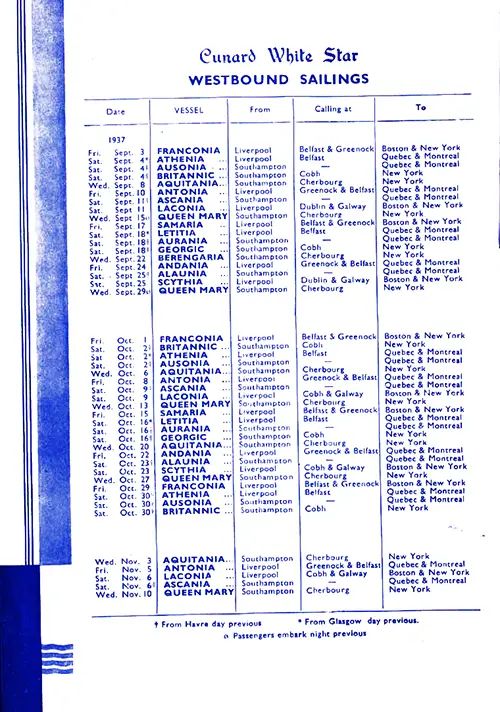RMS Alaunia Archival Collection
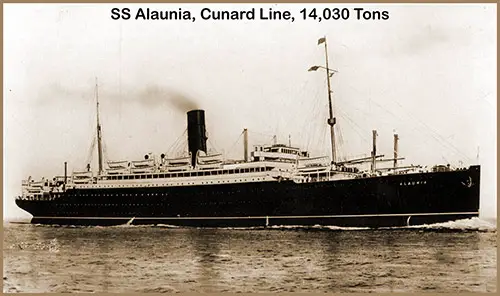
Postcard of the SS Alaunia (1925) of the Cunard Line, 14,030 Tons. | GGA Image ID # 1d2104c996
Content Links
- Alaunia (1913) Cunard Line Ship's History (Brief)
- Alaunia (1925) Cunard Line Ship's History (Brief)
- Passenger Lists
- Passage Rates
- Route Maps, Track Charts, Abstract of Logs
- Sailing Schedules
- Excerpts from Information for Passengers
- Books Referencing the RMS Alaunia
- New Cunard Liner RMS Alaunia Launched - 1925
- The Remarkable Cunard Liner Alaunia - 1925
Alaunia (1913) Cunard Line
Built by Scott's Shipbuilding & Engineering Co., Greenock, Scotland. Tonnage: 13,405. Dimensions: 520' x 64' (540' O.I.). Propulsion: Twin-screw, 16 knots. Quadruple expansion engines. Masts and Funnels: Two masts and two funnels. Passengers: 520 second and 1,540 third class. Maiden voyage: Liverpool-Portland, December 3, 1913. Fate: Sunk by mine two miles from Royal Sovereign, October 19, 1916. Sister ship: Andania.
Alaunia (1925) Cunard Line
Built by John Brown & Co., Clydebank, Glasgow, Scotland. Tonnage: 14,030. Dimensions: 519' x 65' (540' o.l.). Propulsion: Twin- screw, 15 knots. Steam turbines. Masts and Funnels: Two masts and one funnel. Passengers: 500 cabin, 1,200 third. Maiden voyage: Liverpool-Quebec-Montreal, July 24, 1925. Service Beginning 1926: London-Southampton-Canada. WW2 Service: Converted to British armed merchant cruiser in late 1939. Sold to British Royal Navy in December 1944. At the end of the war, the Admiralty purchased her and converted her into a heavy repair ship named HMS Alaunia. Sister ships: Ascania and Aurania. Note: Similar to Andania class. All were designed for the Canadian service. Fate: She was broken up in 1957 at Blyth.
Return to Content Links
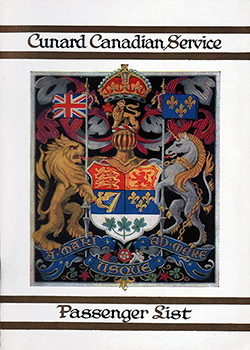
SS Alaunia Passenger lists 1925-1938
All Digitized Lists of Passengers for the SS Alaunia Available at the GG Archives. Listing Includes Date Voyage Began, Steamship Line, Vessel, Passenger Class and Route.
Routes: Liverpool to Québec and Montréal via Belfast; Montréal to London via Plymouth and Le Havre; and Southampton to Québec and Montréal via Le Havre.
Return to Content Links
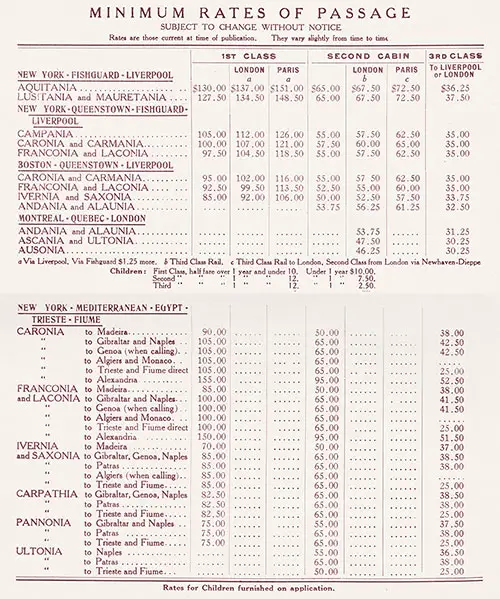
Minimum Rates of Passage, First Class, Second Cabin, or Third Class. Ships Included the Aquitania, Lusitania, Maruetania, Campania, Caronia, Carmania, Franconia, Laconia, Ivernia, Saxonia, Andania, Alaunia, Ascania, Ultonia, Ausonia, Carpathia, and Pannonia. Cunard Line Services 1914 Brochure. | GGA Image ID # 1f7949ddf9
Return to Content Links
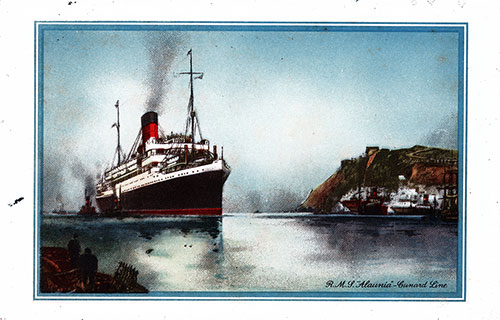
Abstract of Log of the Cunard-White Star RMS Alaunia, from Montréal and Québec to London via Plymouth and Le Havre. Captain P. R. Vaughan, DSC, RD, RNR Commanding. Length of Passage: 6 Days, 23 Hours, 10 Minutes. Average Speed: 14.80 Knots. Start Date: 28 November 1936. End Date: 8 December 1936. Card Shows the Date; Distance Traveled, Latitude, Longitude, and Remarks (mostly Weather Encountered). Front Side: Painting of the RMS Alaunia of the Cunard Line. | GGA Image ID # 1dfeac7706. Reverse Side: Abstract of Log. | GGA Image ID # 1dfeda9d1f
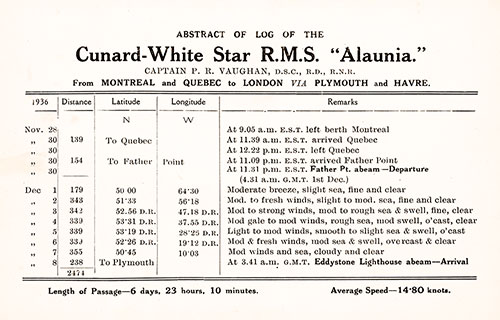
Return to Content Links
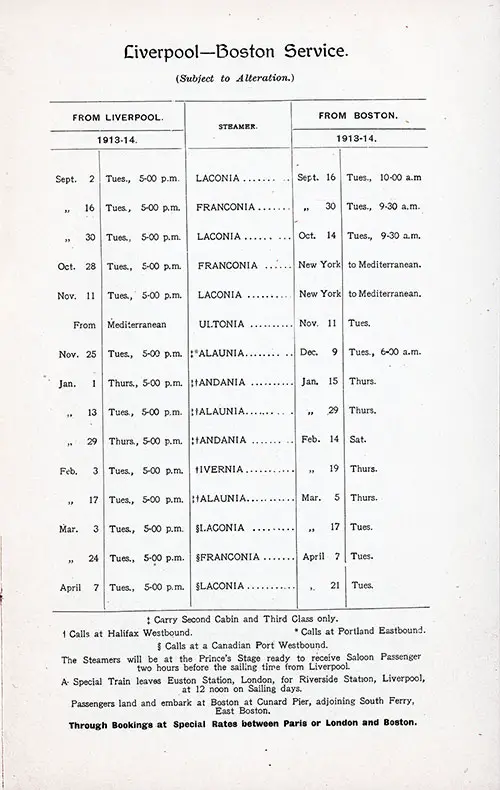
Cunard Liverpool-Boston Service from 2 September 1913 to 21 April 1914. Ships Included the Alaunia, Andania, Francoia, Ivernia, Laconia, and Ultonia. RMS Carmania Passenger List, 23 September 1913. | GGA Image ID # 1dcaaf02a5
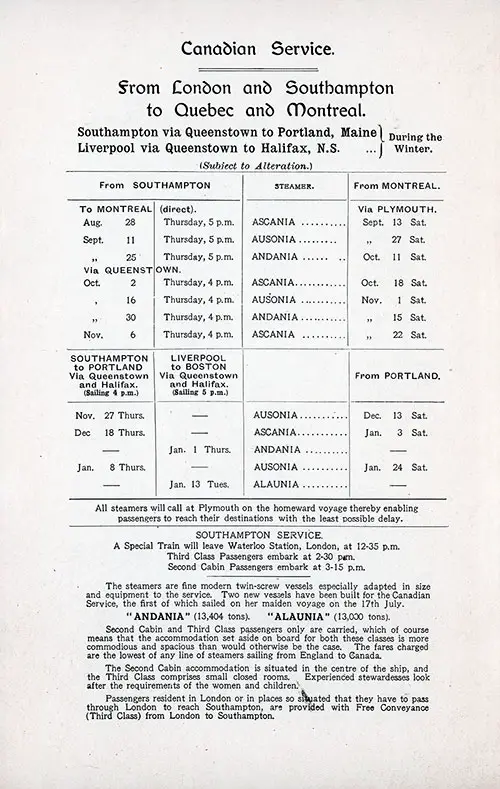
Cunard Canadian Service from 26 August 1913 to 24 January 1914. Ships Included the Alaunia, Andania, Ascania, and Ausonia. RMS Carmania Passenger List, 23 September 1913. | GGA Image ID # 1dcaed5b2e
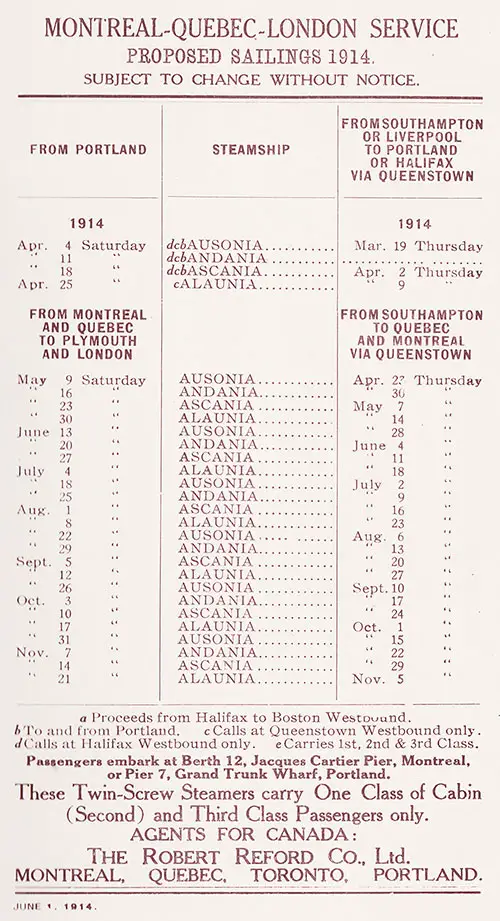
Sailing Schedule, Montreal-Quebec-London Service, from 4 April 1914 to 21 November 1914. Ships Included the Alaunia, Andania, Ascania, and Ausonia. Cunard Line Service 1914 Brochure. | GGA Image ID # 1f7b279b85
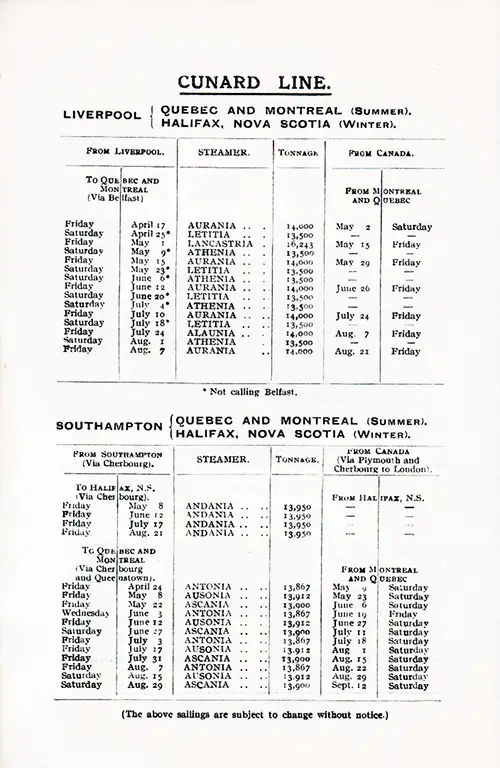
Proposed Sailings, Liverpool-Quebec-Montreal, Liverpool-Halifax, Southampton-Quebec-Montreal, and Southampton-Halifax, from 17 April 1925 to 12 September 1925. Ships included the Alaunia, Andania, Antonia, Ascania, Athenia, Aurania, Ausonia, Lancastria, and Letitia. RMS Andania Passenger List, 6 May 1925. | GGA Image ID # 1e1063298c
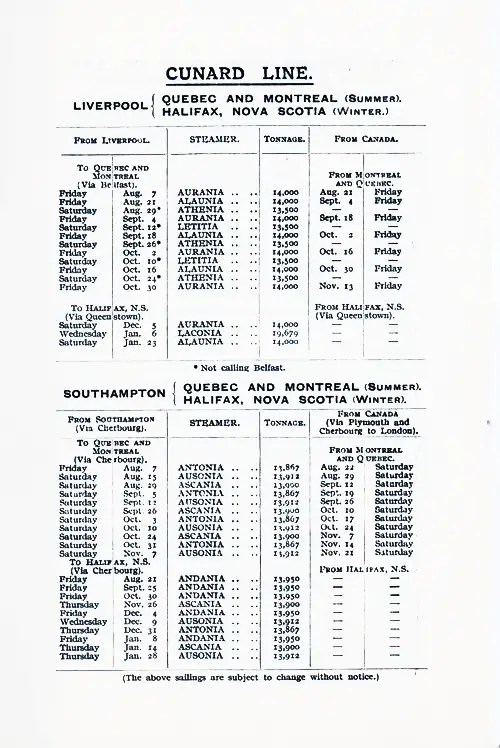
Cunard Line Canadian Service, Liverpool-Canadian Ports, or Southampton to Canadian Ports, from 7 August 1925 to 28 January 1926. Ships Included the Alaunia, Andania, Antonia, Ascania, Athenia, Aurania, Ausonia, Laconia, and Letitia. RMS Alaunia Passenger List, 21 August 1925. | GGA Image ID # 1dff527901
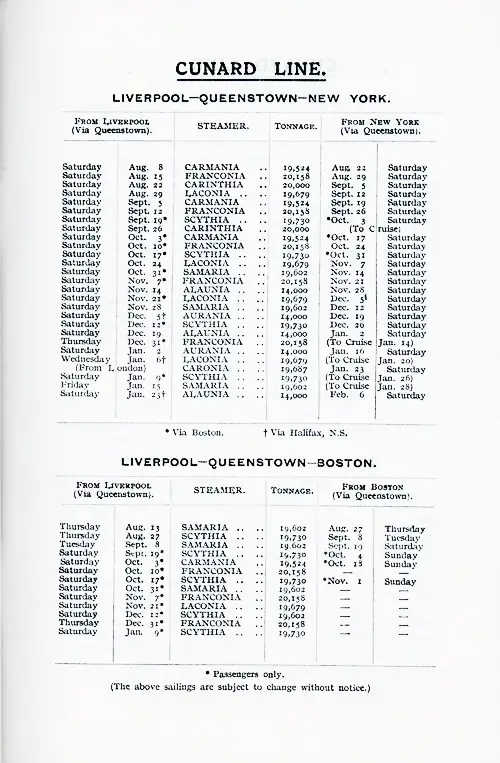
Proposed Sailings, Cunard Line, Liverpool-Queenstown (Cobh)-New York, and Liverpool-Queenstown (Cobh)-Boston, from 8 August 1925 to 6 February 1926. Ships Included the Alaunia, Aurania, Carinthia, Carmania, Franconia, Laconia, Samaria, and Scythia. RMS Alaunia Passenger List, 21 August 1925. | GGA Image ID # 1dff443705
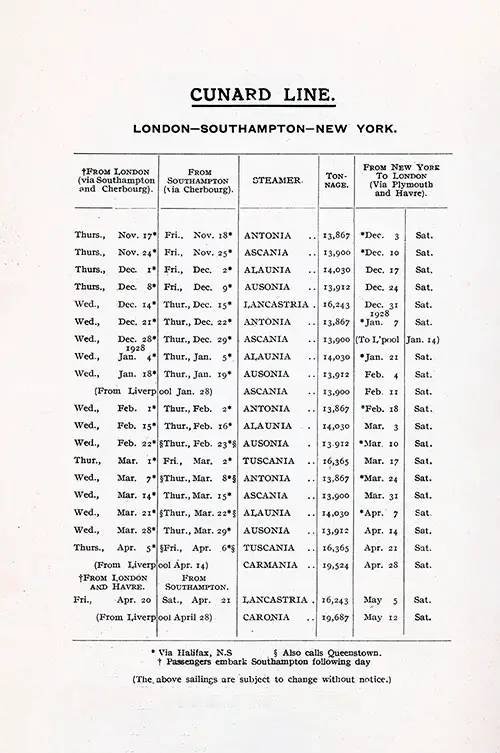
Sailing Schedule, London-Southampton-New York, from 17 November 1927 to 12 May 1928. Ships Included the Alaunia, Antonia, Ascania, Ausonia, Carmania, Lancastria, and Tuscania. RMS Aquitania Passenger List, 26 November 1927. | GGA Image ID # 1e1136df31
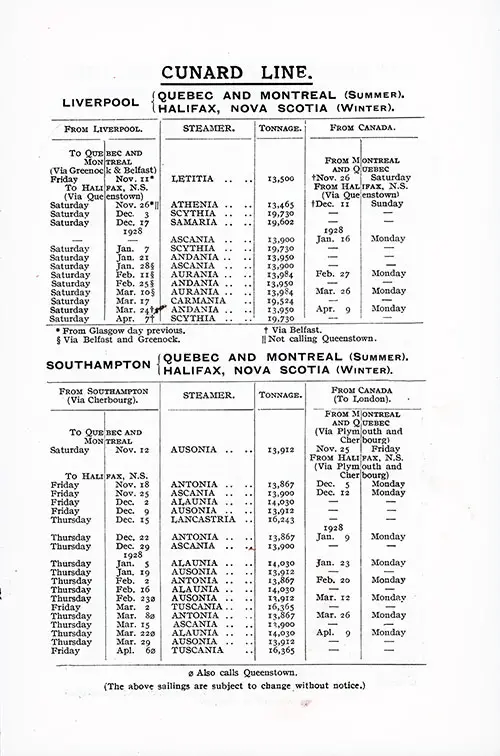
Sailing Schedule, Liverpool-Canadian Ports, from 11 November 1927 to 9 April 1928. Ships Included the Alaunia, Andania, Antonia, Ascania, Athenia, Ausonia, Carmania, Lancastria, Letitia, Samaria, Scythia, and Tuscania. RMS Aquitania Passenger List, 26 November 1927. | GGA Image ID # 1e11e04456
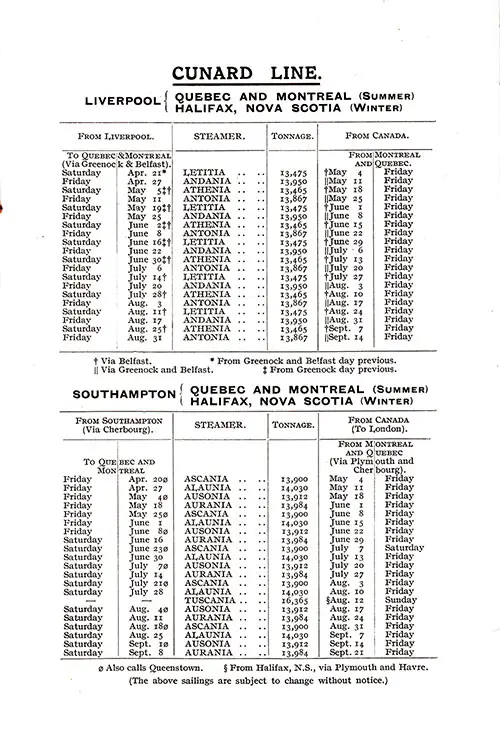
Sailing Schedule, Liverpool or Southampton to Canadian Ports, from 20 April 1928 to 21 September 1928. Ships Included the Alaunia, Andania, Antonia, Ascania, Athenia, Aurania, Ausonia, Letitia, and Tuscania. RMS Ausonia Cabin Passenger List, 4 May 1928. | GGA Image ID # 20a70c7fe4
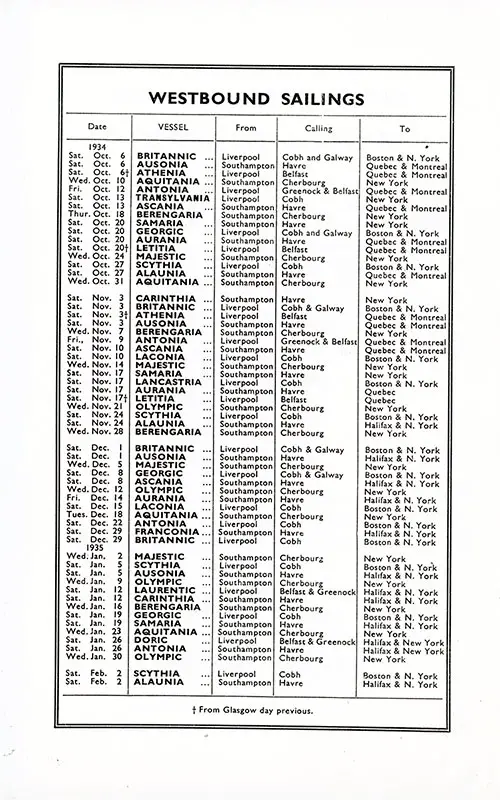
Westbound Sailings of the White Star Line from 6 October 1934 to 2 February 1935. Ships Included the Alaunia, Antonia, Aquitania, Ascania, Athenia, Aurania, Ausonia, Berengaria, Britannic, Carinthia, Franconia, Georgic, Laconia, Lancastria, Laurentic, Letitia, Majestic, Olympic, Samaria, Scythia, and Transylvania. The Schedule Includes Originating, Calling, and Destination Ports for Each Voyage. RMS Britannic Passenger List, 6 October 1934. | GGA Image ID # 1e3159e0ee
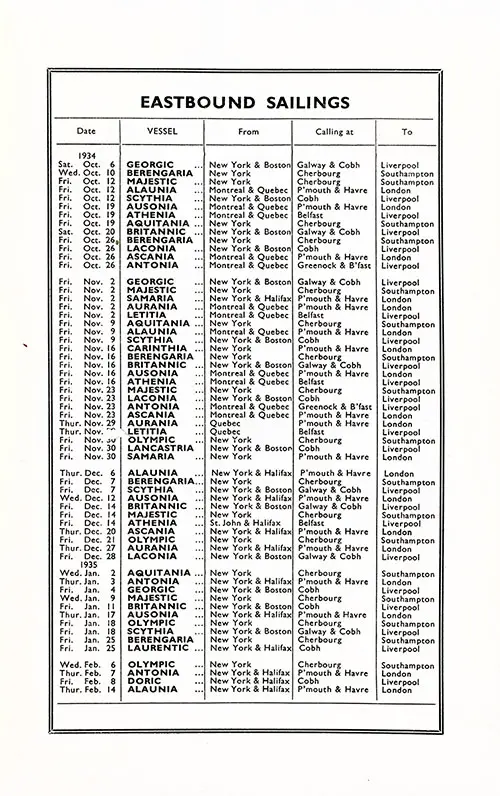
Eastbound Sailings of the White Star Line from 6 October 1934 to 14 February 1935. Ships Included the Alaunia, Antonia, Aquitania, Ascania, Athenia, Aurania, Ausonia, Berengaria, Britannic, Carinthia, Doric, Franconia, Georgic, Laconia, Lancastria, Laurentic, Letitia, Majestic, Olympic, Samaria, Scythia, and Transylvania. The Schedule Includes Originating, Calling, and Destination Ports for Each Voyage. RMS Britannic Passenger List, 6 October 1934. | GGA Image ID # 1e3178f51a
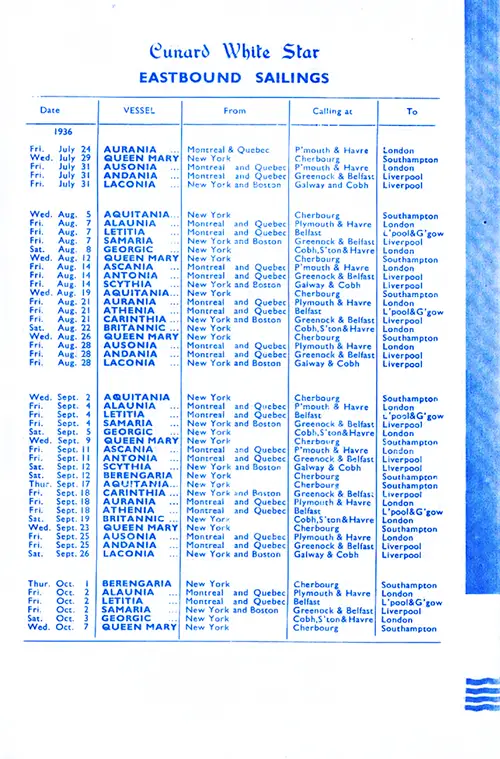
Eastbound Sailing Schedule, from Boston, New York, Québec, or Montréal to Glasgow, Liverpool, London, or Soutampton via Belfast, Cherbourg, Cobh, Galway, Greenock, Le Havre, or Plymouth, from 24 July 1936 to 7 October 1936. Ships Included the Alaunia, Andania, Antonia, Aquitania, Ascania, Athenia, Aurania, Ausonia, Berengaria, Britannic, Carinthia, Georgic, Laconia, Letitia, Queen Mary, Samaria, and Scythia. RMS Samaria Passenger List, 24 July 1936. | GGA Image ID # 1ecd389488
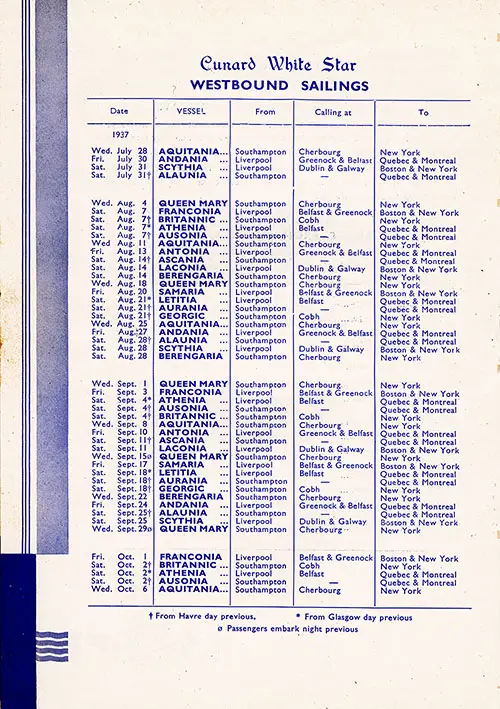
Westbound Sailing Schedule, Cunard White Star Vessels, from 28 July 1937 to 6 October 1937. Ships Included the Alaunia, Andania, Antonia, Ascania, Athenia, Aquitania, Aurania, Ausonia, Berengaria, Britannic, Franconia, Georgic, Laconia, Letitia, Queen Mary, Samaria, and Scythia. RMS Aquitania Cabin Class Passenger List, 28 July 1937. | GGA Image ID # 20bfda234f
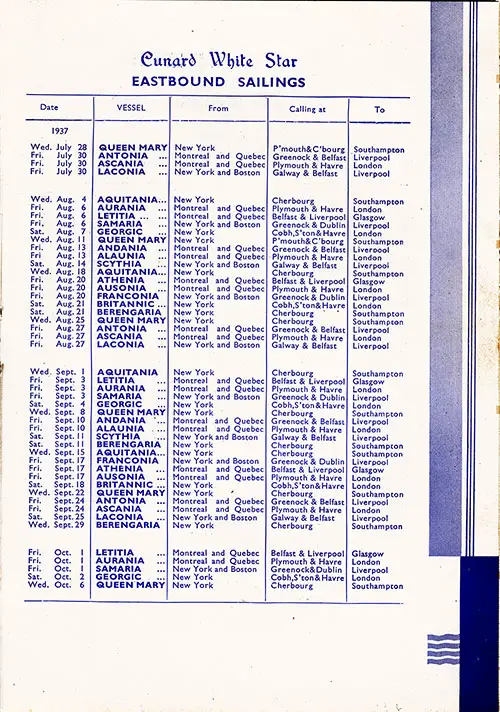
Eastbound Sailing Schedule, Cunard White Star Vessels, from 28 July 1937 to 6 October 1937. Ships Included the Alaunia, Andania, Antonia, Ascania, Athenia, Aquitania, Aurania, Ausonia, Berengaria, Britannic, Franconia, Georgic, Laconia, Letitia, Queen Mary, Samaria, and Scythia. RMS Aquitania Cabin Class Passenger List, 28 July 1937. | GGA Image ID # 20bfdeea90
Cunard White Star Westbound Sailing Schedule for 3 September to 10 November 1937. Ships Include the Alaunia, Andania, Antonia, Aquitania, Ascania, Athenia, Aurania, Ausonia, Berengaria, Britannic, Franconia, Georgic, Laconia, Letitia, Queen Mary, Samaria, and Scythia. | GGA Image ID # 1db7e0cf97
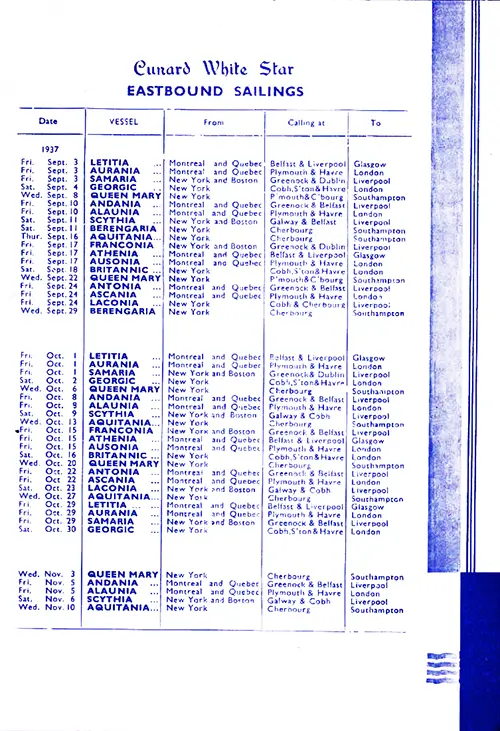
Cunard White Star Eastbound Sailing Schedule for 3 September 1937 to 10 November 1937. Ships Include the Alaunia, Andania, Antonia, Aquitania, Ascania, Athenia, Aurania, Ausonia, Berengaria, Britannic, Franconia, Georgic, Laconia, Letitia, Queen Mary, Samaria, and Scythia. | GGA Image ID # 1db80746e8
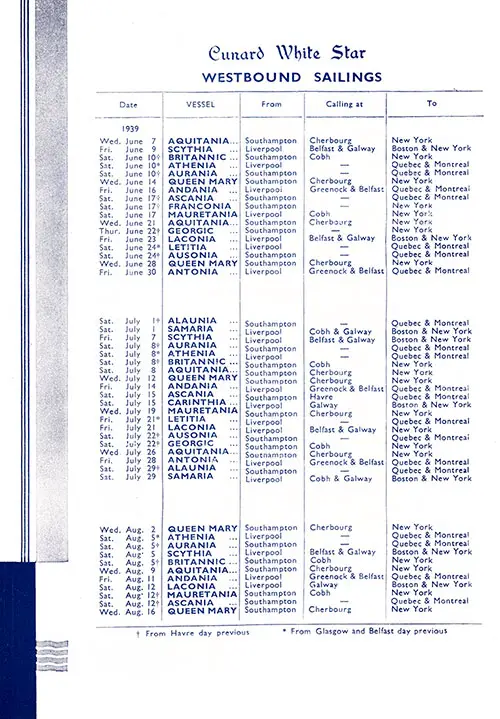
Westbound Sailing Schedule from 7 June 1939 to 16 August 1939. Ships Included the Alaunia, Andania, Antonia, Ascania, Athenia, Aquitania, Aurania, Ausonia, Britannic, Carinthia, Franconia, Georgic, Laconia, Letitia, Mauretania, Queen Mary, Samaria, and Scythia. RMS Aquitania Passenger List, 7 June 1939. | GGA Image ID # 1e141a92c5
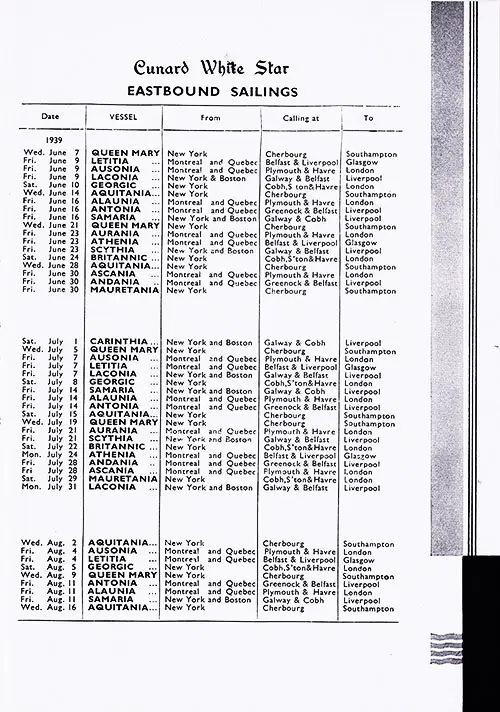
Eastbound Sailing Schedule from 7 June 1939 to 16 August 1939. Ships Included the Alaunia, Andania, Antonia, Aquitania, Ascania, Athenia, Aurania, Ausonia, Britannic, Carinthia, Georgic, Laconia, Letitia, Mauretania, Queen Mary, Samaria, and Scythia. RMS Aquitania Passenger List, 7 June 1939. | GGA Image ID # 1e1424c50b
Return to Content Links
Information for Passengers - 21 August 1925
The Bars in the Cabin will not be open later than 11:00 pm, but it is within the discretion of the Commander to close them during the voyage at any time should he consider this course desirable.
Seats at Table.—Application may be made at any of the Chief Offices in advance, or to the Second Steward on board the Steamer on day of sailing.
Divine Service on Sunday at 10:30 am
Deck Chairs and Rugs may be hired at a cost of 4/2 (or $x.00) each, on application to the Deck Steward. Each Rug is contained in a sealed cardboard box, and bears a serial number worked into the material so that Passengers will have no difficulty in identifying their rugs.
At the end of each voyage, the rugs which have been in use are sent to the store and thoroughly cleaned, before being re-issued.
The Surgeon is authorized to make customary charges, subject to the approval of the Commander, for treating any Passengers at their request for any illness not originating on board the ship. In the case of sickness contracted on board no charge will be made and medicine will be provided free.
Libraries.—In addition to a library of Standard Works, a special selection of up-to-date literature is available for the use of Passengers.
Berth Ladders.—These may be obtained on application to Steward or Stewardess.
Berthing of Passengers.—No alterations can be made except officially through the Purser.
Valuables.—The Company is not responsible for theft if valuables or money are kept in the Staterooms. The same should be placed in charge of the Purser for deposit in his safe, and a receipt will be given on the Company's form.
As no charge is made for carriage the Company cannot accept any responsibility for loss or damage, however arising, but Passengers can protect themselves by insurance.
Payments.—Passengers should obtain a receipt from the Purser on the Company's form for any additional Passage Money, Rugs, Chairs, Excess Baggage, Freight, etc., paid on board.
Dogs.—Passengers are notified that dogs cannot be landed in Great Britain unless a license has previously been procured from the Board of Agriculture, London.
Forms of license must be obtained by direct application to the Department before the dog is taken on board. Dogs are carried at owner's risk, rate being from £3 upwards, payable to the Purser.
Special Information for Westbound Passengers.
Return Accommodation.—For the convenience of those Passengers who may be returning from Canada to Europe and who have not yet made the necessary arrangements, the Purser will be pleased to radio for any accommodation required.
This will enable Passengers to complete their arrangements before leaving the steamer and will consequently save them time and trouble in Canada.
All enquiries regarding baggage on board ship should be addressed to the Baggage Master.
Passengers are specially requested to claim their baggage before leaving the Customs Baggage Room, otherwise, consider. able delay and extra charge for carriage will be incurred in forwarding to destination any baggage not accompanying Passengers on the Railway.
Baggage. — Insurance of Baggage. — The Company, while taking every possible care and precaution, strongly recommend Passengers to insure their baggage, as in the event of loss or damage the Cunard Company cannot accept any liability beyond the amount specified on steamer tickets.
The Company offers facilities for the insurance of baggage prior to embarkation against loss by sea or land, risk of fire. breakage, theft or pilferage.
Stateroom baggage must be limited in size to r4 inches in height, 2 feet in width, and 3 feet 8 inches in length. Packages exceeding these limits are placed in Ship's Hold.
No individual piece of baggage—whether for Hold, Baggage Room, or Stateroom, should exceed 250 lbs. weight.
Articles or packages weighing over 250 lbs. will not be accepted as baggage on the Canadian and United States Railroads. Packing cases, crates, bacon boxes, etc., will not be accepted as baggage, but must be forwarded by freight train in Canada and charges paid on full weight, whether or not the passenger takes baggage with him on the train.
Articles of the nature described below must not be enclosed amongst baggage, viz. :—
Money, jewellery, Negotiable Papers or Valuable Documents of any kind, Perishable Goods, Pictures, Glassware, Bottles, or Bric-a-brac, Liquids.
No liability can be assumed by the Lines for loss of or damage to or caused by such articles.
Dangerous articles, such as Fireworks, Matches, Gunpowder, Gasoline, Cartridges, Moving Picture Films, etc., must not on any account be enclosed in baggage.
Baggage Allowance on Atlantic Steamers is on the following scale for Cabin Passengers :-
Free, 20 cubic feet. Excess Charge, 2/6 per cubic feet.
Arrivals at Québec and Montréal.—Examination of Cabin Passengers takes place at Quebec or on board steamer between Québec and Montréal.
On arrival at Montreal the Customs are in attendance at the Dock, together with Representatives of the Railway Companies, and Passengers destined to interior points holding rail orders, exchange such orders for actual Rail tickets, pass the Customs and check their baggage through to destination.
Passengers are transferred in the Transfer Company's vehicles from the Dock to the Railway Stations.
In the event of the steamer docking at Montreal too late in the evening for Passengers to make connections with the night trains, they may remain on board overnight and disembark at 7-00 am next morning.
Public Telephones.—Telephone service with booths and operator in attendance will be found near the Customs Lines on the Wharf.
Taxicabs can be hired at the Piers.
Money Exchange.—As a convenience to Passengers the Purser has been authorized to carry funds for Exchange purposes, but owing to fluctuations it is not possible to make any fixed Rate of Exchange.
Customs Regulations. — Canada. — Wearing apparel, articles of personal adornment, toilet articles and similar personal effects of persons arriving in Canada may be passed free, without entry at Customs, as travelers' baggage, under the provisions of the Customs tariff, but this provision shall only include such articles as actually accompany and are in use of and as are necessary and appropriate for the wear and use of such persons for the immediate purpose of the journey and present comfort and convenience, and shall not be held to apply to merchandise or articles intended for other persons or for sale.
Settlers' Effects Free of Duty.—Wearing apparel, household furniture, books, implements and tools of trade, occupation or employment; guns, musical instruments, domestic sewing machines, typewriters, live stock, bicycles, carts and other vehicles, and agricultural implements in use by the settler for at least six months before his removal to Canada, not to include machinery or articles imported for use in any manufacturing establishment or for sale; also books, pictures, family plate or furniture, personal effects and heirlooms left by bequest; provided that any dutiable articles entered as settlers' effects may not be so entered unless brought with the settler on his first arrival, and shall not be sold or otherwise disposed of without payment of duty until after twelve months' actual use in Canada.
Source: RMS Alaunia Passenger List -- 21 August 1925
Information for Passengers - 27 August 1938
MEALS will be served as follows :—
When One Sitting
- BREAKFAST from 8-0 a.m.
- LUNCHEON 1-0 p.m.
- DINNER 7-0 p.m.
When Two Sittings
- 8-0 a.m. and 9-0 a.m.
- 12-15 p.m. and 1-30 p.m.
- 6-30 p.m. and 7-45 p.m.
Morning Soup and Afternoon Tea will be served on Deck and in the Public Rooms at 11 a.m. and 4 p.m. respectively.
AUTOMOBILES. In order tö facilitate Customs clearance uncrated automobiles destined to the United States must be included on the U.S. Declaration Form.
BAGGAGE. Questions relating to Baggage should be referred to the Purser or ship’s Baggage Master.
Canadian Customs. Residents of Canada returning from abroad are allowed exemption from Customs Duty for goods valued at not more than S100 if included in the baggage accompanying them and acquired by them for personal or household use as souvenirs or gifts, but not bought for the account of other persons, or for sale.
Alcoholic beverages up to one quart, two pounds of manufactured tobacco, fifty cigars and two hundred cigarettes may be included in the $ 100 exemption allowance, provided they are brought in with the passenger's baggage.
The exemption wiil not be granted to persons under 14 years of age. Where the value of the goods upon which exemption is to be claimed exceeds S5 Declaration Form E. 24, which will be supplied by the Purser, must be completed, in duplicate, by each returning Canadian citizen enumerating all such articles and all values should be shown in Canadian Currency.
The Declaration Form must be completed prior to the arrival of the ship at Quebec or Montreal and handed to the Officer at time of Customs inspection.
U.S. Customs.
All passengers in continuous transit to U.S. are required to make a declaration of personal baggage for the U.S. Customs Authorities at the port of landing.
Blank declaration forms are obtainable from the Purser. Returning Residents must declare all articles acquired abroad but wearing apparel and personal effects taken overseas from the U.S. in the first case are entitled to be passed free of duty upon return.
An exemption of $100.00 worth of purchases is allowed each returning resident, subject to certain conditions which will be detailed by the Customs Officer. Visitors may take in free of duty wearing apparel and personal effects not intended for sale, but must declare all articles not included in this category.
Severe penalties are imposed upon persons who make false declarations as to value, ownership or use of articles or who attempt to bribe or recompense a Customs Officer.
Customs Examination. All articles liable to Customs duty must be declared. Any passenger who is in doubt should see the Purser or Baggage Master who will provide the latest information available.
On arrival baggage will be grouped alphabetically in Customs shed for examination. To help the passing and claiming of baggage passengers should have one of the Company’s labels, bearing the initial letter of their surname, affixed to each piece. The bedroom stewards have a supply of these labels and will affix them prior to landing.
It is for passengers themselves to see that all their baggage is passed by the Customs authorities on landing, and they are specially requested to claim their baggage before leaving the Customs shed, otherwise delay and extra charges for carriage will be incurred in forwarding to destination any baggage not accompanying passengers directly from the ship.
Baggage in Bond. Passengers en route to destinations outside Canada or the U.S.A. may have their checked baggage forwarded “ In Bond ” to a frontier point under Customs Manifest without examination of the contents by a Customs Officer at port of disembarkation. The Purser or Baggage Master will be pleased to supply information.
Baggage Insurance. Passengers are recommended to insure their baggage as the Company’s liability is strictly limited in accordance with the terms of the passage contract. Baggage Insurance carrying worldwide cover can be arranged through the Purser’s office.
BARBER AND HAIRDRESSER. The ship carries a well-equipped Barber’s Shop and competent Hairdresser.
CATERING. Passengers are invited to advise the Head Waiter of their preference in the matter of diet and cooking and they can be assured of every attention to their wishes.
Cooks of various nationalities are included in the kitchen personnel. It is suggested that passengers order their meals in advance, and the aforementioned official will readily assist passengers in making their choice.
CHEQUES. Passengers are advised that the Purser cannot accept private cheques.
CHANGES IN ACCOMMODATION. The Purser alone is authorized to make changes in accommodation and may only do so on payment of any difference in fare which may be required according to the Company’s current tariffs.
COMPLAINTS. Passengers entertaining any cause for complaint are requested to communicate particulars to a responsible officer in the ship, so that an opportunity may be afforded to adjust matters.
DECK CHAIRS, CUSHIONS AND RUGS are available for hire and can be obtained through the Deck Steward at the price of 5/- each article.
(Each rug is contained in a sealed envelope and bears a serial number worked into the material, thus enabling passengers to identify their own rugs).
DOGS. Passengers are notified that dogs should be handed over to the care of the live-stock attendant and that they are not allowed in Public Rooms or on the Passenger Decks.
EXCHANGE OF MONEY. For the convenience of passengers the Purser is able to exchange a limited amount of English, French, U.S. and Canadian money at rates which will be advised on application.
FIRE PRECAUTIONS. Passengers are specially requested to exercise care in disposing of cigar and cigarette ends and matches and to make use of the receptacles provided for the purpose in the different parts of the ship, in view of the serious consequences which can arise from carelessness in this respect. Throwing lighted cigarettes, etc. overboard should also be avoided.
FIRE AND LIFEBOAT STATIONS. Passengers are earnestly requested to acquaint themselves with the notice in the staterooms regarding lifeboat and fire stations.
The Captain specially appeals to Passengers to assist him by promptly mustering at their appointed stations at all times when passenger boat station muster is being held.
Only by immediate attendance at this important muster can passengers obtain the necessary instructions which are so vital to the well-being of all on board. The co-operation of every passenger is earnestly desired.
IMPORTATION OF LIQUOR. A considerable quantity of liquor imported in the baggage of passengers is purchased " in bond " at a price below the regular market value in the country of purchase and for that reason attention is called to the fact by the Collector, U.S. Customs Service, that the above market value must be ascertained and declared by the passenger instead of the price actually paid.
LANDING ARRANGEMENTS. The Purser will furnish passengers with a small card, detailing the landing arrangements, before arrival.
LIBRARY. The ship has a fully-equipped library and passengers are invited to borrow the volumes—no charge will be made.
PASSAGE TICKETS. Passengers are requested to hand their passage tickets to their bedroom stewards as soon as possible after embarkation.
PASSENGERS’ MAIL. Inward and Outward Steamers. Passengers expecting urgent letters or telegrams should notify the Purser’s Office. For the convenience of passengers, telegrams and postal matter are received aboard and distributed but without any responsibility whatsoever on the part of Cunard White Star Limited for non-delivery, mis-delivery or delay.
PAYMENTS. Passengers should obtain a receipt on the Company’s form for any payments made on board for additional passage money, rugs, chairs, excess baggage, etc.
PORTHOLES. As it is dangerous for passengers to handle the ports they are requested to ask the bedroom steward to open and dose the ports in the staterooms as may be desired.
PROFESSIONAL GAMBLERS are reported as frequently travelling in Atlantic ships and passengers are warned to take precautions accordingly.
RADIO AND CABLE MESSAGES. Information and rates will be supplied by the Radio office.
RADIO RECEIVERS AND ELECTRICAL APPARATUS.
Private radio receivers or other electrical apparatus must not be operated or connected to the ship’s electrical supply circuits without official approval, applications for which should be made to the Purser. Passengers using loud-speakers are requested to avoid disturbing their fellow passengers.
RETURN ACCOMMODATION. For the convenience of those passengers who may be returning from Canada or the United States to Europe and who have not yet made the necessary arrangements the Purser will be pleased to radio for any accommodation required. This will enable passengers to complete their arrangements before leaving the ship and will consequently save them time and trouble after landing.
ROTARIANS travelling by this ship are invited to inspect the Rotary Register at the Purser’s office and subscribe their names. The Purser will be glad, providing circumstances permit, to arrange an informal meeting during the voyage.
SPECIAL NOTICE FOR ROUND TRIP PASSENGERS.
All passengers holding return tickets are requested to communicate with the most convenient Company’s office, if possible at least a week in advance of their intended sailing from Canada or the United States, so that the necessary formalities may be arranged in connection with their passage.
If for any reason the holder of a return ticket should be unable to travel by the sailing shown thereon, immediate advice should be given to the nearest Company’s office, so that any accommodation held can be released and new reservation made in sailing selected.
THE SURGEON is authorized to make customary charges for his services, subject to the approval of the Captain.
A REGISTERED NURSE is on board, whose services are available as necessary under the direction of the ship’s Surgeon.
TRAVEL INFORMATION. The Purser’s office is at the disposal of passengers for furnishing detailed information concerning ship, rail or air connections and arrangements can be made for tickets and reservations to be obtained.
UPPER BERTHS. Passengers occupying upper berths can obtain steps for getting in and out of same on applying to the Steward or Stewardess.
VALETING SERVICE. A Clothes pressing room, in charge cf an expert attendant, is provided and work of this kind will be carried out for passengers at the posted charges.
VALUABLES. In their own interests passengers are advised not to leave articles of jewellery and other valuables lying about. Articles not required for frequent wear may be deposited with the Purser and will be placed in an envelope sealed in the presence of the passenger for custody In the ship’s safe.
A receipt will be given but no liability as to contents can be accepted. '
Passengers are advised to protect themselves by insurance, which can be arranged on board on application to the Purser.
Source: RMS Alaunia Passenger List - 27 August 1938
Return to Content Links

Cunard -- few names in the maritime industry are more redolent of the great days of ocean-going passenger liners and cruise ships. This book recalls the era when ocean travel by liner was at its height and the 'Queens' ruled the waves with page after page of beautiful photographs that tell its story. Glory Days: Cunard provides a vivid reminder of the lost grandeur of ocean travel.
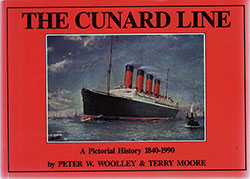
The Cunard Line: A Pictorial History 1840-1990
An Illustrated History of the Cunard Line and the celebrated liners which have served the Fleet, from its Inception in 1840 to the demise of the great transatlantic liners and finally the entry into service of the RMS Queen Elizabeth 2, Britain's last great luxury liner.

Distinguished Liners from The Shipbuilder - 1906-1914 Volume 1
An authentic replication to the smallest detail of the best of The Shipbuilder magazine, 1906-1914, including articles on the Titanic, Olympic, Lusitania, Mauretania, and more. This encyclopedic collection contains original text, photographs, and advertisements, as well as 22 fold-out blueprint plans, five color plates, a two-color Titanic cutaway folding advertisement and even two facsimile subscription forms.
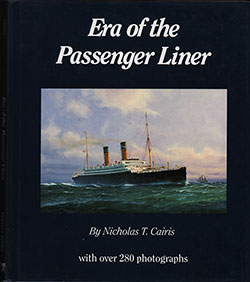
Era of the Passenger Liner - 1992
The Gilded Era comes back to life as the reader relives the careers of stately ships and express greyhounds from immigrant ships to floating palaces. Scarce, large format book containing 288pp. Features photographs, statistics, and background of 280 passenger liners, each with a picture.
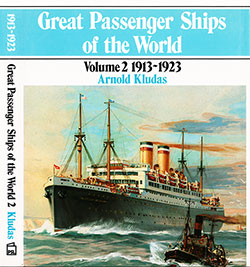
Great Passenger Ships of the World 1913-1923
The period 1913-1923 is dealt with in this second volume. Although it was only a decade, it was one of the most turbulent passenger ships in history. Competition to produce ever-larger vessels declined between leading North Atlantic shipping companies. For 20 years, the ships of the Imperator Class were the largest in the world.

North Atlantic Passenger Liners Since 1900
Material about the most prominent steamship companies on the Atlantic Ferry today and those that have been there for some time. Some Lines have diverse services to other oceans, seas, and continents.

This book recreates the ambiance of the ocean linereraby showing the actual objects used on board. Each piece of ocean-liner memorabilia is like an aladdin's lamp, releasing wondrous memories of that grand style of travel.

Ocean Steamers: A History of Ocean-Going Passenger Steamships 1820-1970
A history of the steam-powered passenger ship that details its story from the SS Savannah of 1819 to the SS Hamburg of 1969. It contains historical details of all civilian vessels built in the intervening years, with numerous illustrations and previously unpublished material.
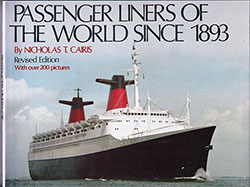
Passenger Liners of the World Since 1893
The author here takes a nostalgic look back to the heyday of the passenger ship, providing a brief history of 211 ships of over 10,000 tons, together with specifications and technical details of each.
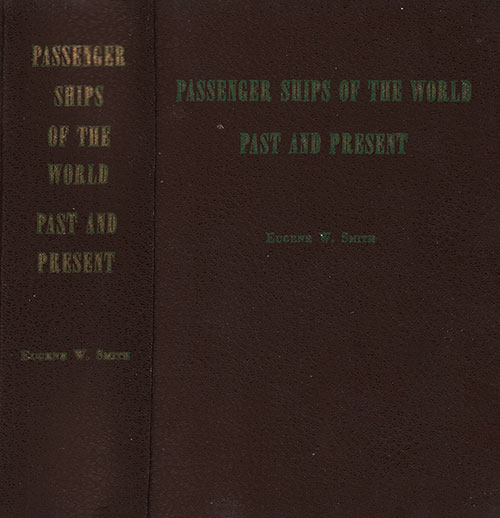
Passenger Ships of the World - 1963
🎓 “A Global Voyage Through Steamship History for Historians, Genealogists, and Maritime Enthusiasts”
Eugene W. Smith’s Passenger Ships of the World – Past and Present (1963) is a masterfully curated encyclopedic reference that charts the rise, peak, and transformation of ocean-going passenger ships through nearly two centuries. Expanding upon his earlier Trans-Atlantic and Trans-Pacific works, Smith offers a global maritime panorama that includes ships serving the Americas, Africa, Europe, Asia, Australia, and Oceania, as well as Canal routes and California-Hawaii shuttle lines.
🧭 This book is an essential resource for:
- Maritime historians seeking design evolution and fleet data
- Genealogists tracing voyages and shipping lines
- Educators and students studying transoceanic migration and tourism
- Ship modelers, naval architects, and enthusiasts interested in dimensions, tonnage, and speed

Picture History of British Ocean Liners: 1900 to the Present
Over 200 rare black-and-white illustrations provide views of the ships at sea and in port, glimpses of lavish staterooms, lounges, dining areas, onboard photos of celebrities and royalty, and much more.

Picture History of the Cunard Line 1840 - 1990
The Picture History of the Cunard Line 1840 - 1990 has over 180 photographs and illustrations showing the liners on the high seas and in port and depicting handsome staterooms, lounges, interior decor, and carefree life aboard ship.
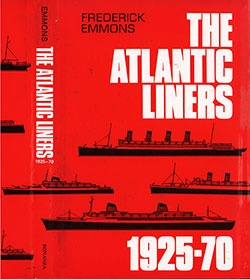
THE ATLANTIC LINERS will be cherished by all the millions of Americans who love the sea. Frederick Emmons sketches the histories of every ocean liner that sailed between the United States and Europe between 1925 and 1970.
Return to Content Links
New Cunard Liner RMS Alaunia Launched - 1925
The latest Cunard liner, the Alaunia, was launched at Clydebank on February 7. This ship only has accommodations for cabin and third-class passengers and is intended for Canadian service. The general particulars are as follows:
- Length overall, 540 feet.
- Beam, molded, 65 feet.
- Depth, molded to shelter deck, 45 feet.
- Gross tonnage, 14,000.
- Cargo capacity, 400,000 cubic feet.
- Passenger capacity, cabin, 520; third class, 1,152; and crew, 319.
The ship has seven decks, a double bottom, two masts, and one funnel. The propelling machinery consists of 2 sets of Parsons turbines, driving twin screws through double reduction gearing. With the propellers making 90 revolutions per minute, a total of about 8,500 shaft horsepower will be developed. The designed sea speed is 15 knots. There are two double and two single-end boilers, 17 feet 6 inches in diameter and 22 feet 6 inches and 11 feet 6 inches in length. The total heating surface is 19,900 square feet, and the working pressure is 220 pounds per square inch. The boilers are arranged to bum oil on the Wallsend-Howden pressure system.
Electricity is extensively employed throughout the vessel, being utilized for driving forced draft fans, unitary, ballast, and emergency bilge pumps, turbine turning gear, steering gear, refrigerating machiner)', stores' elevators, ventilating fans and bakery and galley machines. Two geared turbo generators supply current on the 3-wire system, the voltage for lighting being 110 and power 220. The total capacity is 300 kilowatts.
Marine Engineering and Shipping Age, March 1925, p. 183.
Return to Content Links
The Remarkable Cunard Liner Alaunia - 1925
An average of one Cunard liner every second year for 60 years—and one over for luck—is the record of the Clydebank shipyard. There were, of course, many more or less lengthy spells without any launches for the big Liverpool concern, but that is how the average works out.
The Alaunia is the 31st vessel built for the Cunard Line since 1864. She is as notable in her way as many of lier predecessors. She is not in the classes represented by the Aquitania, the Lusitania, the Carmania-Caronia pair, or that fine post-war ship, the Franconia (all of them Clydebank productions).
Still, as an intermediate two-cabin liner, she will have few equals and no superiors on the St. Lawrence route. She is a twin-screw, double reduction, geared turbine vessel, 540 ft. in extreme length, 65 ft. in molded breadth, 43 ft. in-depth molded to shelter- deck, of 14,000 tons gross, 8,000 SHP at 90 RPM, and 15 knots sea speed.
On six of her seven decks, she will carry 414 cabin passengers, 1,152 third class, and a crew of 319—a total of 1,885.
The cabin passengers will have two, three, and four berth staterooms, while there will be two private suites, each including a sitting room, two bedrooms, and a bathroom.
The public spaces, complete descriptions of which are not yet available, will consist of a dining saloon, winter garden, long gallery, drawing room, smoking room, gymnasium, and children's room.
Third-class passengers will have two and three- berth cabins, two large dining saloons, two general rooms, a smoking room, a children's room, and an extensive covered and open promenading area.
For cargo carriage, there will be 400,000 cubic feet of space, so the vessel should be capable of earning revenue of both kinds substantially, given reasonably good trading conditions.
The propelling machinery, fitted in one engine room, will consist of two sets of Parsons turbines developing an aggregate of 8,500 SHP and giving a total for astern work about 63 percent of that far ahead. Each group of turbines consists of one high-pressure and one low-pressure, with astern turbines incorporated in the casings of the low-pressure ahead turbines.
The steam generators will consist of two double-ended and two single-ended boilers arranged in one boiler room, working under Howden's forced draught and designed for a pressure of 220 lb.
The boilers are of the multitubular, return-tube type; each of the double-ended has eight furnaces with eight separate combustion chambers, and each of the single-ended has four furnaces with four combustion chambers. The oil-burning system is the Wallsend-Howden. The apparatus consists of two complete sets of pumping and heating plant—one as a standby.
The combined heating surface of all the boilers is 19,900 sq. ft., and the furnaces can be changed rapidly from oil to coal or from coal to oil; the boilers are led to a single oval funnel.
The vessel's electric generating plant consists of two impulse turbines running at 5,000 revolutions and geared to three-wire, direct-current generators of 300 kW. output, supplying energy at two pressures: 220 volts for power and 110 volts for lighting.
The Alaunia, it may be added, is the twelfth unit of the Cunard Company s program of passenger vessels and is the last but one of the six cabin and third-class ships in that program.
With the Aurania, the Athenia, and the Letitia, she will maintain regular sailings between Liverpool and St. Lawrence, calling at Belfast for the convenience of Irish travelers.
The Syren and Shipping, 11 February 1925, p. 491+
Return to Content Links

